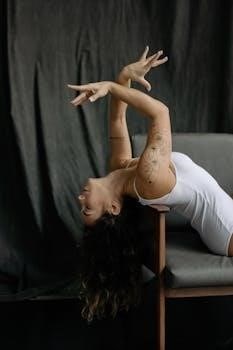
Yoga flow sequences are dynamic series of poses linked together with breath. These sequences, like Pilates Roll Up Flow or Hippie Flow, enhance flexibility, strength, and mindfulness. They are adaptable and can be modified for various needs and skill levels.
What is a Yoga Flow Sequence?
A yoga flow sequence is a thoughtfully arranged series of yoga poses, or asanas, that are connected by smooth transitions and synchronized with the breath. Unlike holding static poses, a flow encourages continuous movement, creating a meditative dance-like experience. These sequences can vary significantly in style and intensity, from gentle, restorative movements to more challenging, dynamic flows. They aren’t limited to mat work; flows can also be done using a chair or other props. The primary goal is to link poses together in a harmonious way that builds heat, flexibility, and focus, while promoting a state of mental calmness and physical well-being. Yoga flow sequences are suitable for all experience levels, as they can be modified to suit individual needs and limitations.
Benefits of Practicing Yoga Flows
Practicing yoga flows offers numerous physical and mental advantages. Physically, it enhances flexibility, strength, and balance, while promoting cardiovascular health through dynamic movement. Regular flow practice can also aid in injury recovery, and weight management. Mentally, yoga flows reduce stress and anxiety by promoting a sense of calm and mindfulness. The rhythmic connection of breath and movement cultivates focus and concentration, while the meditative aspect encourages self-awareness and emotional balance. Furthermore, it can help alleviate chronic conditions by improving circulation and reducing inflammation. Gentle flow yoga, in particular, is beneficial for those seeking relaxation and increased flexibility. Overall, consistent practice leads to better physical health, mental clarity, and emotional stability.
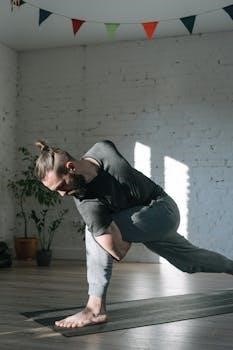
Types of Yoga Flow Sequences
Yoga flows vary widely, including Vinyasa, Gentle, Yin, and Chair Yoga. Each type offers unique benefits, focusing on different aspects like strength, flexibility, relaxation, and accessibility.
Vinyasa Flow and its Characteristics
Vinyasa flow is characterized by its dynamic and fluid movements, linking each pose with the breath. This style often builds heat and strength through continuous motion. Vinyasa sequences are known for their creativity, incorporating various poses and transitions. They are designed to move from open hip poses to more challenging closed hip poses. This flow can involve a variety of standing poses, twists, and balancing postures, creating a unique experience. The focus on breath synchronizes the body and mind, fostering a meditative state. Vinyasa is a versatile practice, suitable for building power and flexibility, and it can be adapted to different fitness levels. This makes it a popular choice for those seeking a more active yoga practice.
Gentle Flow Yoga for Relaxation and Flexibility
Gentle flow yoga sequences prioritize relaxation and flexibility through slow, mindful movements. These flows are less physically demanding than other styles, focusing on contemplative postures. Gentle flow aids in stress management, injury recovery, and weight management while improving overall health. It integrates gentle movement with restorative poses, emphasizing deep breath awareness. Students are encouraged to explore subtle sensations within their bodies, promoting relaxation and self-awareness. This practice helps individuals find stillness and ease tension, making it suitable for those seeking a calming yoga experience. Gentle flows are beneficial for all ages and fitness levels, offering a path to improved mobility and reduced chronic conditions. It is a safe option to reduce stress and promote overall well-being.
Yin Yoga Sequences for Pain Relief and Deep Stretch
Yin yoga sequences are designed to target deep connective tissues, promoting pain relief and profound stretching. These sequences often involve holding poses for longer durations, allowing for a deeper release of tension. Yin yoga is particularly beneficial for relieving back pain and counteracting the effects of prolonged sitting. It focuses on flexibility, touching on a bit of everything moving from the feet up through the shoulders. It encourages exploration of the four principles of yin yoga to enhance the practice. This style helps to improve joint mobility and reduces stiffness. It is a useful tool for those seeking to address chronic pain and improve their overall flexibility through static poses, a slow pace and a deep focus.
Chair Yoga Flows for Accessibility and Support
Chair yoga flows offer accessible and supportive options for those with limited mobility or physical constraints. These sequences adapt traditional yoga poses to be performed while seated on a chair. Chair yoga allows individuals to experience the benefits of yoga without requiring the ability to get down on the floor. It can incorporate various movements, like Sun Salutation variations and hip openers, while seated. Chair yoga is particularly useful for those with back pain, injuries, or other physical conditions. It is a gentle way to improve flexibility, strength, and circulation, making yoga accessible to a wider range of people. It offers support and promotes well-being for all.
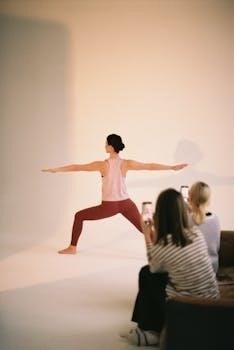
Creating Your Own Yoga Flow
Crafting a personal yoga flow involves setting intentions, selecting key poses, and understanding transitions. Modify sequences based on individual needs and levels to personalize your practice.
Setting an Intention for Your Practice
Before starting your yoga flow, take a moment to set an intention. This intention acts as a focal point, guiding your energy and attention throughout the practice. It could be anything from cultivating inner peace to building strength or flexibility. Your intention could even be to manage stress or simply to move your body with awareness. This conscious choice helps make your practice more meaningful, allowing you to align your physical movements with a deeper purpose. Setting an intention also promotes a sense of mindfulness, encouraging you to stay present and focused during your yoga session, enhancing both physical and mental benefits.
Key Poses and Transitions in a Sequence
A well-structured yoga flow sequence incorporates key poses that build upon each other, creating a harmonious movement. Standing poses often transition from open-hip to closed-hip postures, progressing from accessible to more challenging positions. Transitions between poses are just as vital as the poses themselves, ensuring a smooth, continuous flow. These transitions can include simple steps, lunges, or more complex movements, requiring core engagement and balance. For example, moving from a plank to a downward-facing dog or stepping forward into a lunge. Focusing on seamless transitions maintains momentum and enhances the overall flow of the sequence, creating a dynamic and engaging practice.
Modifying Sequences for Different Needs and Levels
Adapting yoga flow sequences to accommodate diverse needs and levels is crucial for inclusivity and safety. Modifications allow beginners, those with injuries, or advanced practitioners to benefit fully. For instance, chair yoga is a great option for those with mobility limitations, providing support and accessibility. Gentle flow sequences are suitable for relaxation and flexibility, while more dynamic flows can build strength and endurance. Poses can be simplified by using props, such as blocks or straps, or by reducing the range of motion. Listening to the body and adjusting the sequence ensures that every practice is safe, comfortable, and effective, and it can be personalized to individual needs.
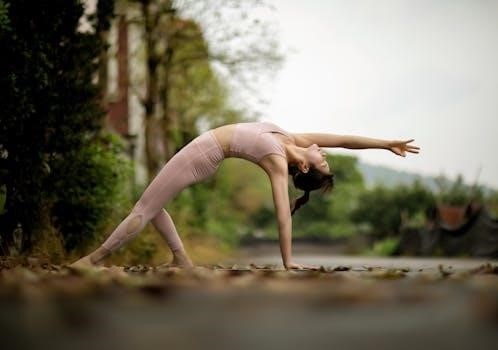
Yoga Flow Resources and Examples
Numerous resources offer yoga flow examples, including printable mini-flows and sequences for specific areas, such as hips or shoulders. These resources aid both teachers and students in their practice.
Printable Mini-Flows for Home Practice
For convenient home practice, printable mini-flows offer structured sequences that are easy to follow. These short, stackable flows, often consisting of around 10 poses or movements, can be used to build full classes or as standalone sessions. They explore diverse styles from Hatha and Vinyasa to gentle Yin. Resources like Yoga Humans provide guides and printable sequences for various themes, such as hip opening, core strength, or balancing. These mini-flows are great for quick workouts, allowing practitioners to explore creativity and integrate them into their personal routines. They are accessible and perfect for busy schedules, making regular practice more manageable and enjoyable.
Sequences for Specific Areas like Hips, Shoulders, and Core
Yoga sequences can be tailored to target specific areas of the body, offering focused benefits. For hips, sequences like the “Hip Opening Yoga Sequence” or flows that feature lunges and twists improve mobility and flexibility. Shoulder-focused flows, often incorporating external rotations and stretches, alleviate tension. Core-centric sequences, with movements that build power and stability, enhance overall strength. These specialized flows often combine dynamic movements with stretches to address specific needs, like opening the muscles for Dancers Pose or preparing for Firefly. Resources often provide sequences for areas like hamstrings, wrists, and glutes, allowing practitioners to create custom practices.
Examples of Creative and Dynamic Yoga Flows
Creative and dynamic yoga flows go beyond traditional sequences by incorporating unique transitions and poses. Examples include flows with arm balances, inversions, and fun balancing shapes. Some dynamic sequences build heat through movements that work multiple areas like shoulders, hips, and lower body. “Grounded Airplane” inspired flows engage the core and test balance, while “Birds of Paradise” sequences blend balance, fluidity, and challenge. These flows often feature innovative combinations of familiar poses, moving around the mat. The aim is to make practice both challenging and playful, encouraging exploration of movement and strength.
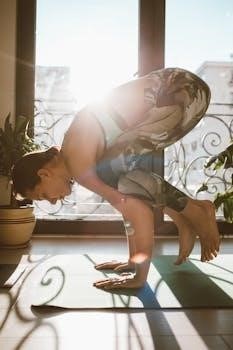
Advanced Yoga Flow Techniques
Advanced yoga flow techniques integrate challenging elements like arm balances and inversions. Props can be used to enhance flows, and sequences can focus on building both strength and flexibility.
Integrating Arm Balances and Inversions
Integrating arm balances and inversions into your yoga flow adds a layer of challenge and excitement. These poses, such as Firefly (Titibasana), require strength, balance, and a deep connection with your core. A preparatory sequence should include poses that warm up the wrists, shoulders, and core. Progressing slowly and safely is paramount to avoid injuries. Start with foundational poses before advancing into full expressions of inversions, such as headstands or handstands. Use modifications and props as needed to support your practice. Remember that falling out is part of the learning process. The goal is to approach these poses with playfulness, not pressure. Eventually, the integration will flow seamlessly within your practice, building both physical and mental resilience.
Using Props to Enhance Your Flow
Props are invaluable tools for enhancing your yoga flow, making poses more accessible and deepening stretches. Blocks can extend your reach in standing poses or provide support in seated postures. Straps help lengthen hamstrings and open shoulders, enabling you to experience poses more fully. A chair can be used for modified versions of poses, as seen in Chair Hip Opening And Strength Flow, making yoga accessible for all body types. Blankets can cushion joints or provide support in restorative postures. Using props encourages proper alignment and supports your individual needs. Experimenting with different props in your flow will increase stability, comfort, and overall enjoyment of the practice. Props can transform your flow into a safe and effective experience.
Sequences for Building Strength and Flexibility
Yoga flow sequences can be specifically designed to build both strength and flexibility. These sequences often incorporate dynamic movements that challenge muscles and promote range of motion. Flows that include lunges, squats, and planks build strength in the legs, core, and upper body. Poses that focus on stretching, like hip openers and hamstring stretches, increase flexibility. Sequences like a strong flow focusing on dynamic movements or those for legs and hips are great examples. Creative flows that use arm balances also build strength, while flows with twists enhance flexibility. Using a combination of strength-building and flexibility-enhancing poses will help develop a well-rounded practice. Regular practice of these flows will improve balance, coordination, and overall physical well-being.